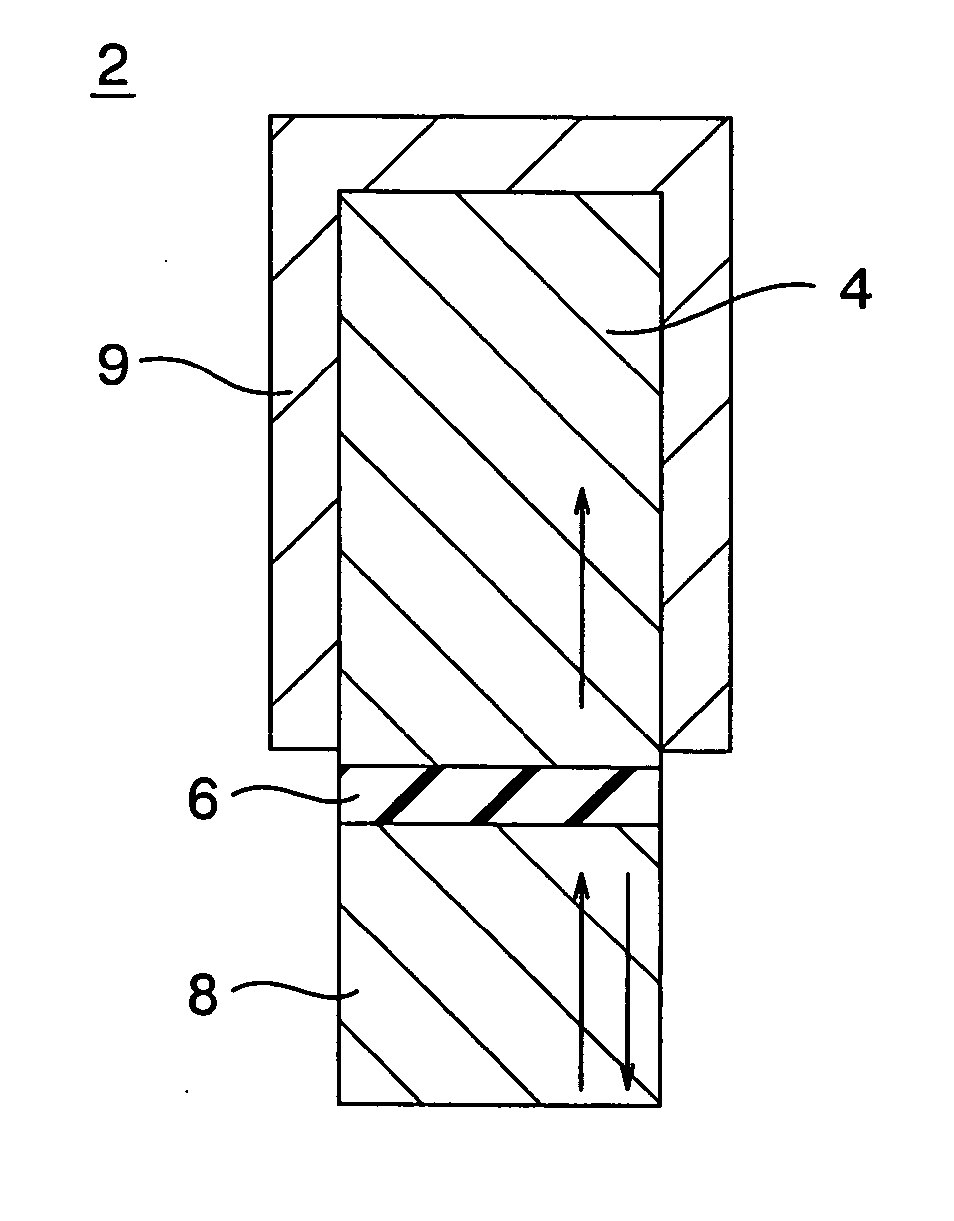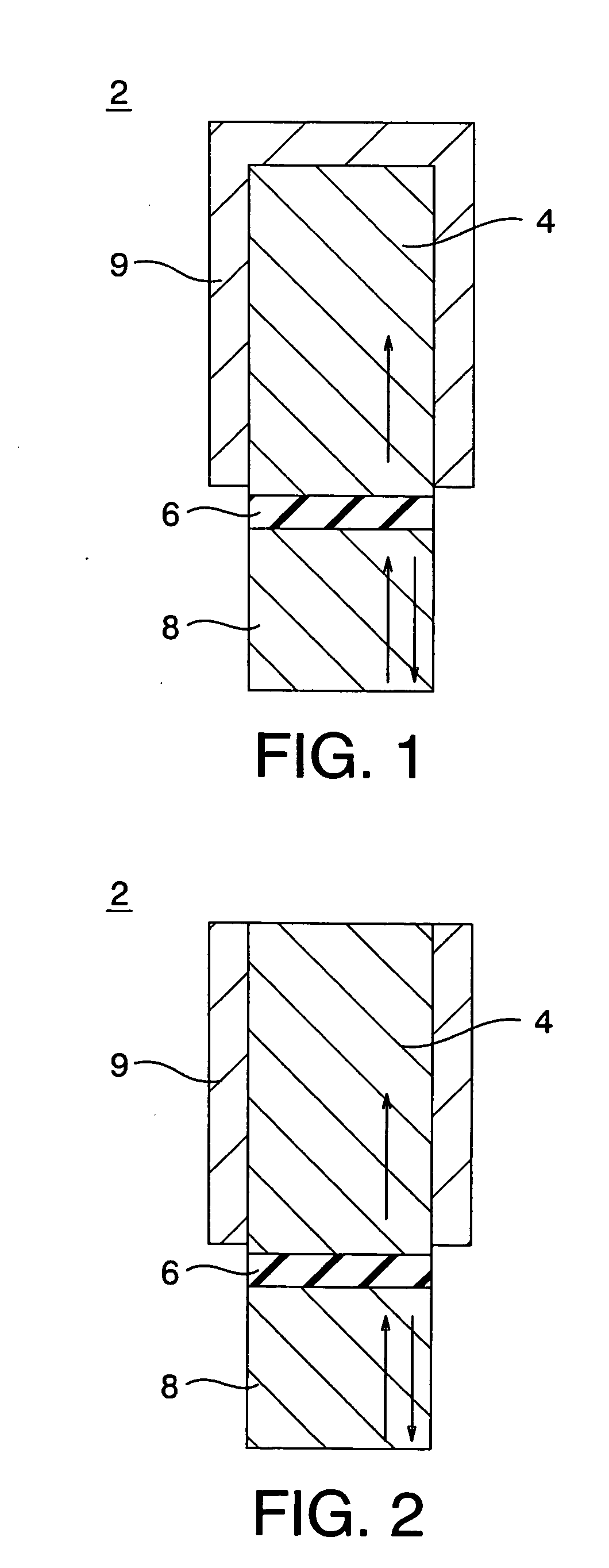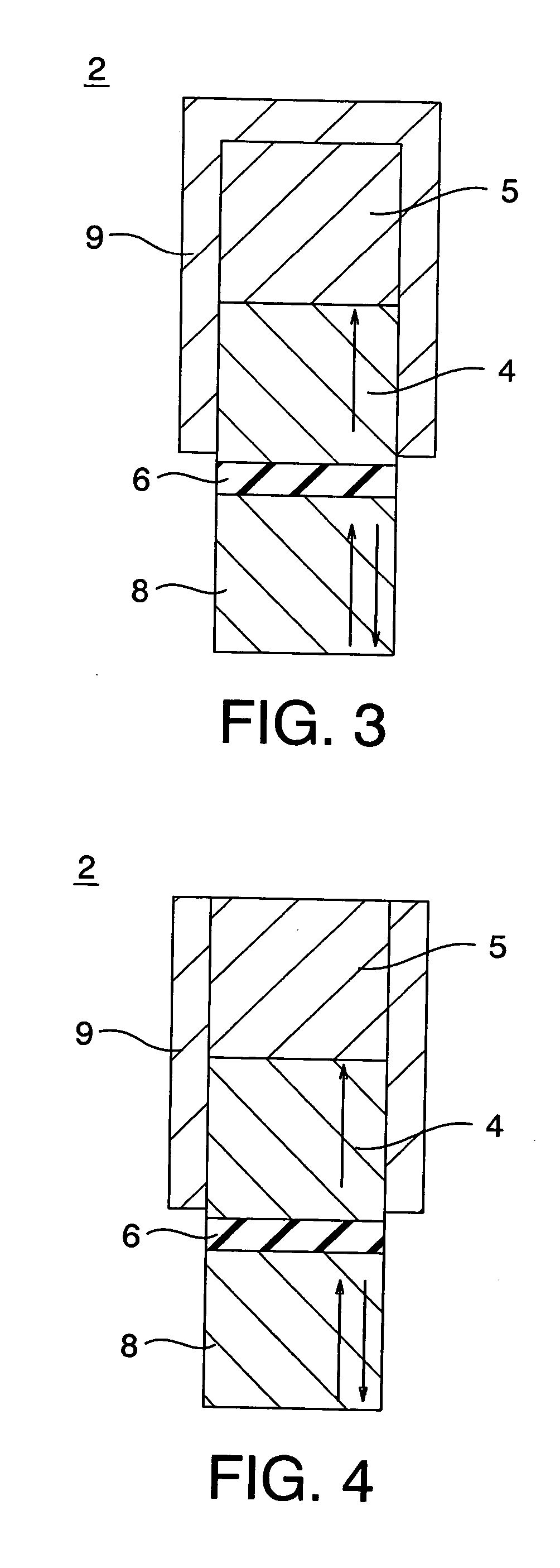Magneto-resistive effect element and magnetic memory
a magnetic memory and effect element technology, applied in the direction of spin-exchange-coupled multilayers, instruments, substrates/intermediate layers, etc., can solve the problems of inability to keep heat stability of magnetic materials, extremely poor thermal stability of bits of the plurality of magnetic domains, and inability to make a memory cell smaller than the size of a semiconductor dram (dynamic random access memory), etc., to achieve excellent heat stability and keep stable magnetic domains.
- Summary
- Abstract
- Description
- Claims
- Application Information
AI Technical Summary
Benefits of technology
Problems solved by technology
Method used
Image
Examples
first embodiment
[0061] (First Embodiment)
[0062] A constitution of a magneto-resistive effect element according to a first embodiment of the present invention is shown in FIG. 1. The magneto-resistive effect element 2 according to this embodiment is a TMR element, and comprises a magnetization-pinned layer (to be also referred to as a pinned layer hereinafter) 4 having a perpendicular spin moment, a magnetization free layer (to be also referred to as a free layer hereinafter) 8 having a perpendicular spin moment and serving as a magnetic recording layer, a tunnel barrier layer 6 provided between the magnetization-pinned layer 4 and the magnetization free layer 8, and an anti-ferromagnetic film 9 covering side surfaces of the magnetization-pinned layer 4 and a surface of the magnetization-pinned layer 4 opposing the tunnel barrier layer 6.
[0063] In this manner, in the magneto-resistive effect element according to the embodiment, the anti-ferromagnetic film 9 is formed on at least side surfaces of th...
second embodiment
[0064] (Second Embodiment)
[0065] A constitution of a magneto-resistive effect element according to a second embodiment of the present invention is shown in FIG. 2. The magneto-resistive effect element 2 according to the embodiment has a constitution obtained by removing the anti-ferromagnetic film 9 on the surface of the magnetization-pinned layer 4 opposing the tunnel barrier layer 6 from the magneto-resistive effect element 2 according to the first embodiment shown in FIG. 1, i.e., forming the anti-ferromagnetic film 9 only on the side surfaces of the magnetization-pinned layer 4.
[0066] For this reason, even though the magneto-resistive effect element is miniaturized, the spin moment direction of the magnetization-pinned layer 4 is perpendicularly oriented by exchange coupling between the anti-ferromagnetic film 9 and the magnetization-pinned layer 4. Even though switching of the magnetic fields is repeated, the magnetic domain of the magnetization-pinned layer 4 does not vary. T...
third embodiment
[0067] (Third Embodiment)
[0068] A constitution of a magneto-resistive effect element according to a third embodiment of the present invention is shown in FIG. 3. The magneto-resistive effect element 2 according to the embodiment has a constitution obtained by forming a nonmagnetic conductive layer 5 on the upper surface of the magnetization-pinned layer 4 in the magneto-resistive effect element 2 according to the first embodiment shown in FIG. 1.
[0069] In the magneto-resistive effect element according to the embodiment, the anti-ferromagnetic film 9 is formed on at least side surfaces of the magnetization-pinned layer 4. Therefore, the spin moment of the magnetization-pinned layer 4 is perpendicularly oriented by exchange coupling between the magnetization-pinned layer 4 and the anti-ferromagnetic film 9 even though the magneto-resistive effect element is miniaturized, and the magnetization of the magnetization-pinned layer 4 does not vary even though switching of the magnetic fiel...
PUM
| Property | Measurement | Unit |
|---|---|---|
| thickness | aaaaa | aaaaa |
| thickness | aaaaa | aaaaa |
| thickness | aaaaa | aaaaa |
Abstract
Description
Claims
Application Information
 Login to View More
Login to View More - R&D
- Intellectual Property
- Life Sciences
- Materials
- Tech Scout
- Unparalleled Data Quality
- Higher Quality Content
- 60% Fewer Hallucinations
Browse by: Latest US Patents, China's latest patents, Technical Efficacy Thesaurus, Application Domain, Technology Topic, Popular Technical Reports.
© 2025 PatSnap. All rights reserved.Legal|Privacy policy|Modern Slavery Act Transparency Statement|Sitemap|About US| Contact US: help@patsnap.com



